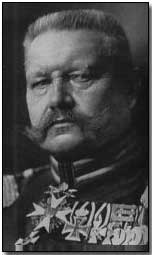
Tannenberg: a Monument of German Pride
by Peter K. Gessner
In the interwar period a monument was erected at Hohenstein then in German East Prussia (now Olsztynek in the Polish voivodship of Warmia and Mazury) to the celebrate the late August 1914 WWI battle in which the German Army surrounded and annihilated the Russian Second Army commanded by General Samsonov. In part the battle took place in the vicinity of the village of Tannenberg, the location where some 500 years earlier the combined Polish-Lithuanian forces had dealt a crushing defeat to the Teutonic Knights, a German Military Order. The 1914 victory became known in Germany as the Second Battle of Tannenberg. On this latter occasion the German victory had been total: of the 150,000 strong Russian Second Army 92,000 had been taken prisoner and another 30,000 were killed or wounded. Only around 10,000 of Samsonov's men had escaped. In the face of the defeat, Samsonov walked off into the woods and committed suicide.
 The Tannenberg munument at Hohenstein |
In 1924, on the 10th anniversary of the battle, Field Marshal Paul von Hindenburg, who had commanded the German troops in the battle, took part in the laying of the monument's foundation stone, a ceremony attended by some 60 thousand people, primarily veterans of WWI. The monument was built in the period 1925-27. Hindenburg, who in 1916 became Chief of Staff of the German Army. He became President of Germany after the war and as such he appointed Adolf Hitler to be its Chancellor in 1933.
 Field Marshal Paul von Hindenburg |
The monument acquired new and greater importance after Hitler came to power in Germany. The Nazis made it a symbol of the glory of the German Armed Forces. Already in August 1933 the monument was visited by Hitler as the Chancellor of the German Reich. His visit was the occasion for a great patriotic gathering. The greatest ceremony in the history of the monument was, however, the funeral of Field Marshal Hindenburg. Although this had not been either Hindenburg or the monument's planners intention. Hitler had decided that the monument should become a mausoleum for Hindenburg and his wife,
 Tower in which rested Hindenburg sarcophagus |
On the 7th of August 1934, the body of the Field Marshal was laid to rest to the sound of church bells and in the presence of high government officials and representatives of foreign nations. Hitler gave the funerary oration ending it with the high flying words "Toter Feldherr, geh' ein in Walhall!" (Supreme leader, enter Walhalla.) The Tannenberg monument itself was elevated to the rank of a "Monument of German Pride", the only such in all of Germany. It became a symbol, a myth, a place of pilgrimage for thousands of Germans. School children were required to visit it and it was the site of the annual reunions of the veterans of WWI.
Then came the Second World War. On January 20th 1945, as the Soviet Armies advanced into East Prussia, the Germans military, fearing profanation by the Russian, evacuated the remains of the Field Marshal and his wife. After a perilous journey these found a lasting resting place, probably in Marbourg Cathedral. A day later, at night, the Germans blew up both the entrance tower and the one that had housed the Hindenburg tomb. The Soviets did not further destroy the monument which stood till 1949 when its building materials began to be utilized in the construction of the Palace of Culture in Warsaw and of the Headquarters building of the Workers (communist) Party there.
Nothing remains of the monument today other than its buried foundations. The area is now an Olsztynek city park.
Clicking on the visuals will link to the visual's original location.
This page may include copyrighted material, and is to be used for educational and research purposes only
| Info-Poland a clearinghouse of information about Poland, Polish Universities, Polish Studies, etc. |